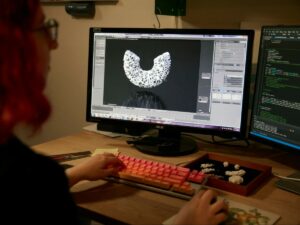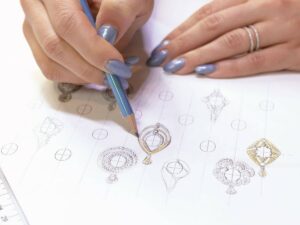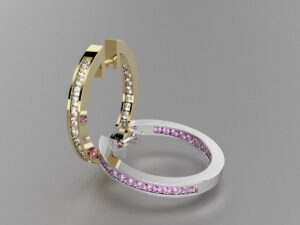This is a comprehensive guide focused on the transformative role of Computer-Aided Design (CAD) in jewellery design.
With years of experience in traditional and CAD jewellery crafting, I’m well-positioned to guide you through the intricacies and benefits of CAD-based designs.
In the realm of modern jewellery crafting, CAD has emerged as a cornerstone technology. It offers unprecedented precision and flexibility, enabling designers to elevate their artistry to new heights while ensuring consistency and speed in production.
In the following sections, we’ll cover everything from CAD basics to advanced trends, serving as a roadmap for both novices and experts in jewellery design.
So let’s get started; there’s a wealth of information awaiting you.
1. The Basics of CAD Jewellery Design
Computer-aided design (CAD) in jewellery is the use of computer software to aid in the creation, modification, and optimization of a design. This technology allows designers to preview 3D jewellery models with impressive precision before production. Having worked closely with both traditional and CAD designs, I’m always amazed at the accuracy CAD brings to the table.
The embrace of CAD is evident in the growing popularity of 3D-printed jewellery. According to Technavio, the 3D printed jewellery market size is estimated to grow at a CAGR of 22% between 2022 and 2027, forecasting an increase of USD 3,711.23 million in the market. This trend further underscores the significant impact and potential of CAD technology in modern jewellery design.
2. Advantages of Using CAD in Jewellery Design
In the ever-evolving realm of jewellery design, adopting advanced technologies like CAD (Computer-Aided Design) has become pivotal. It not only streamlines the design process but also introduces an element of precision and versatility that was previously unattainable. Here, we delve into the myriad advantages that CAD offers in the context of jewellery design, tailored for a B2B audience who is keen on revolutionizing their craft:

-
Precision and Accuracy – CAD allows for incredibly precise designs, minimizing errors and ensuring that intricate details are captured perfectly every time.
-
Cost-Efficiency – By reducing the chances of errors during the design phase, businesses can save on material and labour costs associated with corrections and adjustments.
-
Customization – CAD software makes it easier to personalize jewellery designs, meeting specific customer preferences and demands, hence offering a competitive edge.
-
Speed and Efficiency – Through CAD, designers can quickly modify and adapt designs, significantly reducing the time taken from concept to prototype.
-
Streamlined Production – CAD integrates seamlessly with CAM (Computer-Aided Manufacturing), making the transition from design to production smooth and efficient.
-
Visual Communication – Using CAD, designers can create realistic 3D renderings of jewellery pieces, facilitating better communication and visualization for clients before the piece is manufactured.
-
Consistency – CAD ensures uniformity in design, particularly beneficial when creating multiple units of the same design, maintaining a consistent quality and standard.
-
Innovation and Creativity – CAD offers a plethora of tools and features that encourage designers to experiment and innovate, pushing the boundaries of traditional jewellery design.
-
Digital Archiving – Designs can be saved digitally, creating a comprehensive archive that can be accessed and modified at any time, thereby safeguarding against loss or damage of physical prototypes.
-
Environmentally Friendly – By optimizing designs and reducing waste, the CAD process is a more
environmentally sustainable option, aligning with the growing emphasis on eco-friendly business practices.
We see that integrating CAD into the jewellery design process is an astute business move, fostering innovation, efficiency, and a heightened level of precision that sets the stage for a successful venture in the modern jewellery industry.
3. Tools and Software for CAD Jewellery Design
In the competitive arena of jewellery design, utilizing state-of-the-art tools and software can give businesses a decisive edge. Here, we highlight ten stellar tools and software platforms that are indispensable for professionals seeking to elevate their CAD jewellery design capabilities to the next level. Each of these platforms boasts features and capabilities that are tailormade for enhancing the precision and artistry of jewellery designs:
-
RhinoGold – This specialized jewellery CAD software integrates with Rhino, offering a range of tools that are optimized for jewellery design, facilitating the creation of intricate, detailed, and beautiful pieces.
-
MatrixGold – Built on the popular Rhino software, MatrixGold combines the best features of RhinoGold with a suite of comprehensive tools and features to assist designers in crafting intricate and personalized jewellery designs.
-
3Design – A comprehensive jewellery design software that facilitates the creation of highly detailed 3D models, offering a realistic visualization to designers and clients alike.
-
JewelCAD – A popular choice in the jewellery industry, JewelCAD offers a user-friendly interface with powerful design tools, making the transition from concept to 3D model smooth and efficient.
-
AutoCAD – While not exclusively for jewellery design, AutoCAD’s powerful suite of tools can be employed to create precise and detailed jewellery designs, with extensive customization options.
-
ZBrush – This digital sculpting tool allows for a high degree of artistic freedom in jewellery design, facilitating the creation of intricate and complex pieces with a hands-on, sculptural approach.
-
Blender – A versatile, open-source 3D computer graphics software that can be adapted for jewellery design, offering a range of tools for modeling, rendering, and animation.
-
T-Splines – Often utilized alongside Rhino, T-Splines offers advanced surface modeling tools, helping designers to create smoother and more organic shapes and forms in their jewellery designs.
-
Magics – A part of the Materialise software suite, Magics offers powerful tools for the preparation and management of 3D print models, streamlining the process from design to production.
-
KeyShot – A 3D rendering software that integrates with various CAD platforms, KeyShot allows for the creation of realistic and visually stunning renderings of jewellery designs, enhancing presentations and marketing materials.
|
Software
|
Description
|
Special Features/Strengths
|
|
RhinoGold
|
Specialized CAD software for jewelry that integrates with Rhino.
|
Optimized tools for intricate jewelry designs.
|
|
MatrixGold
|
Builds on Rhino, offering a combination of the best features of RhinoGold.
|
Suite of tools for personalized jewelry designs.
|
|
3Design
|
Comprehensive jewelry design software offering detailed 3D models.
|
Realistic visualization of designs.
|
|
JewelCAD
|
User-friendly interface that streamlines the design process from concept to 3D model.
|
Efficient transition from idea to model with powerful tools.
|
|
AutoCAD
|
General-purpose CAD software adapted for jewelry design.
|
Precision and extensive customization for designs.
|
|
ZBrush
|
Digital sculpting tool allowing high artistic freedom.
|
Hands-on, sculptural approach to intricate designs.
|
|
Blender
|
Open-source 3D graphics software adaptable for jewelry design.
|
Versatile with tools for modeling, rendering, and animation.
|
|
T-Splines
|
Used with Rhino to offer advanced surface modeling.
|
Facilitates creation of organic shapes and smooth forms.
|
|
Magics
|
Part of Materialise software for managing 3D print models.
|
Streamlines process from jewelry design to production.
|
|
KeyShot
|
3D rendering software integrating with various CAD platforms.
|
Produces realistic renderings, enhancing marketing and presentation materials.
|
Understanding these advanced tools and software platforms can significantly propel a business’s ability to create captivating and technically sound jewellery designs, heralding a new era of innovation and excellence in the industry. At Rexjewel, we’ve leveraged these cutting-edge tools and platforms to consistently produce pieces that set industry benchmarks for quality and creativity.
4. Designing with CAD: Step-by-Step Guide
In the world of jewellery, CAD (Computer-Aided Design) has heralded a transformative era, offering unparalleled precision, innovation, and efficiency. The fusion of artistic creativity with technological prowess means that designers can breathe life into their visions with remarkable accuracy. Here’s a step-by-step guide to understanding the design process using CAD:
Step#1 Conceptualization and Sketching
Before diving into the digital realm, it’s crucial to have a clear concept in mind. The designer typically begins with hand sketches, outlining the basic shapes, features, and elements they want to incorporate into the final piece. This phase allows for freehand creativity and sets the foundation for the next steps.
For instance, consider a designer envisioning a nature-inspired necklace. Initial sketches might focus on intertwining vines, leaves, and maybe an embedded gemstone representing a flower.
Step#2 Digital Model Creation
Transferring the sketch into CAD software, the designer crafts a 3D digital model of the piece. This is where the magic of CAD truly shines as the digital model allows for adding intricate details, precise measurements, and the ability to view the design from multiple angles.
Imagine, for example, a ring design with a complex lattice structure. Using CAD, the designer can fine-tune the weave, ensuring uniformity and stability in the final product.
Step#3 Refinement and Iteration
With the initial digital model, the designer can make modifications and refinements. This stage often involves multiple iterations, tweaking design elements to ensure aesthetics and functionality are perfectly balanced. Think of a pendant with an intricate geometric pattern. The designer might adjust angles, enhance symmetry, or modify the pendant’s thickness for optimal wear and visual appeal.
Step#4 Rendering and Visualization
Once satisfied with the design, the designer generates a high-quality 3D render. This offers a realistic visualization of the jewellery piece, showcasing its brilliance, texture, and how it interacts with light. Such renders are invaluable for presentations, client approvals, or marketing purposes.
Take the case of a pair of earrings with a cascading design. A lifelike render can display how the earrings would dangle, and how light would reflect off the surfaces, and provide a near-real viewing experience for prospective buyers or clients.
Step#5 Preparation for Production
After finalizing the design, the CAD file is prepared for production. This may involve creating molds or setting parameters for 3D printing. The designer ensures that the file is compatible with the manufacturing processes and tools to be employed.
For instance, a bangle with a unique twist design would require attention to details like wall thickness, ensuring it’s neither too thin nor too thick. Similarly, a brooch with multiple assembled parts would need each component designed for easy assembly post-production.
5. CAD vs. Traditional Jewellery Design
The age-old art of jewellery design has witnessed a seismic shift with the advent of CAD (Computer-Aided Design). Both methods come with their unique strengths and limitations. To understand the nuances and make an informed decision between CAD and traditional design methodologies, it’s vital to delve into the advantages and disadvantages of each.
CAD Jewellery Design
Advantages:
-
Precision and Detailing: CAD allows for intricate designs with a high degree of precision, capturing even the tiniest details with accuracy.
-
Ease of Modification: Changes can be swiftly made to digital designs, offering flexibility and reducing time in revisions.
-
Efficient Reproductions: CAD designs can be consistently replicated, ensuring uniformity in multiple pieces.
-
Virtual Visualization: 3D renderings offer a realistic view of the finished product, aiding in client presentations and approvals.
-
Seamless Integration with Production: CAD files can be directly used for modern manufacturing processes like 3D printing or CNC milling.
Disadvantages:
-
Steep Learning Curve: Mastering CAD software requires time and training.
-
Initial Investment: Acquiring CAD software and the necessary hardware can be costly.
-
Over-reliance on Technology: Designers might become too dependent on software, potentially stifling hands-on creativity.
-
Technical Glitches: Software can sometimes have bugs or glitches which can disrupt the design process.
-
Detachment from Traditional Craft: CAD doesn’t offer the tactile experience and might create a disconnect from the hands-on artistry of jewellery-making.
Traditional Jewellery Design
Advantages:
-
Tactile Experience: Crafting jewelry by hand provides a tangible, organic connection with the materials.
-
Inherent Artistry: Traditional methods have a rich history, carrying centuries of techniques and artistic expressions.
-
Unique Pieces: Each handcrafted piece can have subtle differences, making them one-of-a-kind.
-
No Technical Hurdles: Designers aren’t bound by software limitations or the need for technological know-how.
-
Immediate Material Interaction: Designers can instantly see how materials behave and make on-the-spot decisions.
Disadvantages:
-
Time-Consuming: Crafting by hand can be labor-intensive and slow, especially for intricate designs.
-
Chance of Inconsistencies: Reproducing the exact design multiple times by hand can lead to slight variations.
-
Limited by Skill: The final output is directly tied to the artisan’s skill level; there’s little room for error.
-
Difficulty in Visualization: Clients can’t view a realistic finished product until it’s physically created.
-
Higher Material Wastage: Traditional methods might result in more material wastage compared to precise CAD-driven processes.
In essence, while CAD offers technological precision and adaptability, traditional jewellery design carries the charm and essence of handcrafted artistry. The choice between the two largely depends on the desired outcome, resources, and personal preferences of designers and clients.
6. Trends and Innovations in CAD Jewellery Design
The dynamic realm of jewelry design continually evolves, with CAD (Computer-Aided Design) standing at the forefront of this evolution. As technology advances, CAD doesn’t just reflect the latest trends; it actively shapes and defines them. Below, we explore four notable trends and innovations that are currently reshaping the landscape of CAD jewelry design.
Hyper-Realistic Rendering
Enhanced software capabilities now allow for hyper-realistic rendering of jewelry designs, making the virtual pieces almost indistinguishable from their real counterparts. These lifelike images are revolutionizing client presentations and marketing campaigns. Clients can “see” a piece before it’s made. Marketing becomes more compelling. Decisions are expedited.
Augmented Reality (AR) Integration
Augmented Reality is bridging the gap between virtual designs and real-world experiences. Designers can overlay digital jewelry pieces onto a real-time video feed of the client, allowing them to “try on” virtual jewelry. Personalized shopping experiences are enhanced. It fosters client engagement. The decision-making process is streamlined.
Parametric and Generative Design
Beyond traditional design methods, CAD now employs algorithms to generate patterns and structures based on set parameters. This creates unique and intricate designs, which would be incredibly challenging, if not impossible, to conceive manually. Designs achieve unparalleled complexity. Each piece can be truly unique. It encourages innovative thinking.
Integration with Advanced Manufacturing Techniques
CAD is seamlessly merging with new-age manufacturing techniques, especially 3D printing. This integration means designs can be directly transferred to production, creating pieces that are incredibly precise and consistent with the digital model. Production times are reduced. Material wastage is minimized. Consistency across batches is ensured.
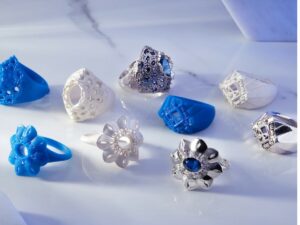
The synergy between technology and artistry in CAD jewelry design is creating an exciting era of possibilities. These innovations not only expand the horizons of design but also redefine the experience of buying and wearing jewelry.
7. Challenges and Pitfalls in CAD Jewellery Design
While the integration of CAD (Computer-Aided Design) in jewelry design has undoubtedly propelled the industry to new heights, it hasn’t come without its challenges. Every technological leap, while introducing benefits, often brings along its set of hurdles. Here are four significant challenges and pitfalls that designers face in CAD jewelry design:
Steep Learning Curve
Embracing CAD tools requires designers to undergo extensive training, demanding a considerable investment in time and resources. The technical complexities of software platforms can sometimes overwhelm artists more attuned to traditional methods. Transitioning can be daunting. Mastery demands dedication.
Over-reliance on Technology
There’s a potential danger of becoming overly dependent on CAD tools, risking the erosion of foundational design skills. Some designers may find themselves constrained by the software’s limitations rather than guided by pure creativity. Artistry might be compromised. Innovation could stagnate.
Technical Glitches and Software Limitations
No software is perfect; technical issues can arise, leading to potential disruptions in the design process. Moreover, while CAD tools are powerful, they can’t always capture the nuanced details or effects that a designer envisions. Workflow disruptions are possible. Fidelity to vision might be compromised.
High Initial Investment
Procuring the latest CAD software and maintaining it can require significant financial outlays. For smaller design houses or independent designers, this investment can pose substantial financial challenges. Start-up costs can be prohibitive. Updates might strain budgets.
8. 5 Factors for Successful CAD Jewellery Design
In the bustling arena of jewelry wholesaling and distribution, integrating CAD (Computer-Aided Design) has become an indispensable strategy. The power of CAD, when wielded effectively, can provide a competitive edge, streamlining design, production, and distribution processes. For wholesalers and distributors looking to optimize their CAD endeavors, here are five critical factors for achieving success in CAD jewelry design:
#1 Proficient Training and Skill Development
To harness the full potential of CAD, it’s imperative to invest in comprehensive training and ongoing skill development. Mastery of the software not only ensures precise and intricate designs but also facilitates smoother communication with manufacturers and clients. A well-trained designer can accurately bring visions to life, setting the stage for consistent and high-quality production.

#2 Understanding Market Trends
In the dynamic world of jewelry, staying abreast of market trends is crucial. A successful CAD jewelry design not only integrates technological precision but also resonates with the prevailing tastes and preferences of the target audience. Wholesalers must ensure that their designs align with market demands, balancing innovation with consumer appeal.
#3 Seamless Integration with Manufacturing
CAD designs should be created with the manufacturing process in mind. This means understanding the capabilities and limitations of production techniques, whether traditional craftsmanship or modern methods like 3D printing. By ensuring compatibility between design and production, wholesalers can achieve efficiency, reduce wastage, and ensure the final product mirrors the digital design.
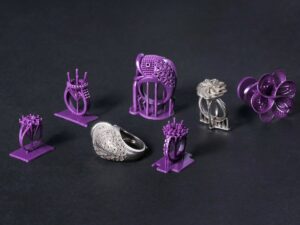
#4 Robust Quality Assurance Protocols
Quality assurance is paramount, especially in the wholesale domain where large batches are produced. At Rexjewel, we implement rigorous QA protocols to ensure that the final jewelry pieces match the CAD designs in terms of dimensions, details, and overall aesthetics. Regular checks and balances guarantee consistency across large production runs, reinforcing our commitment to excellence.
#5 Open Communication and Collaboration
CAD design is not an isolated endeavor; it thrives on collaboration. Engaging openly with manufacturers, clients, and other stakeholders ensures that design visions align with practicalities and market demands. Regular feedback loops and open channels of communication foster improvements, adaptations, and innovations in the design process.

In the realm of wholesale jewelry, CAD presents a goldmine of opportunities. By focusing on these key factors, wholesalers and distributors can navigate the challenges and nuances of CAD design, crafting pieces that captivate consumers and drive business growth.
Dive Deeper Into Our Resources
Looking for more diverse product options? Browse through our handpicked selections:
For some insightful reads, we’ve curated a list of recommended articles just for you:
Still haven’t found what you’re looking for? Don’t hesitate to contact us. We’re available around the clock to assist you.
Conclusion
To wrap it up, we see the myriad facets of CAD in jewelry were unveiled. The blog highlighted its transformative power, balancing benefits and challenges, and pinpointing successful drivers.
Businesses and industry experts with queries or insights about CAD’s role in jewelry are encouraged to connect. Rexjewel, a renowned jewelry manufacturer, is poised to offer deeper perspectives. Contact us and engage with us to open doors to potential partnerships and enrich knowledge.


